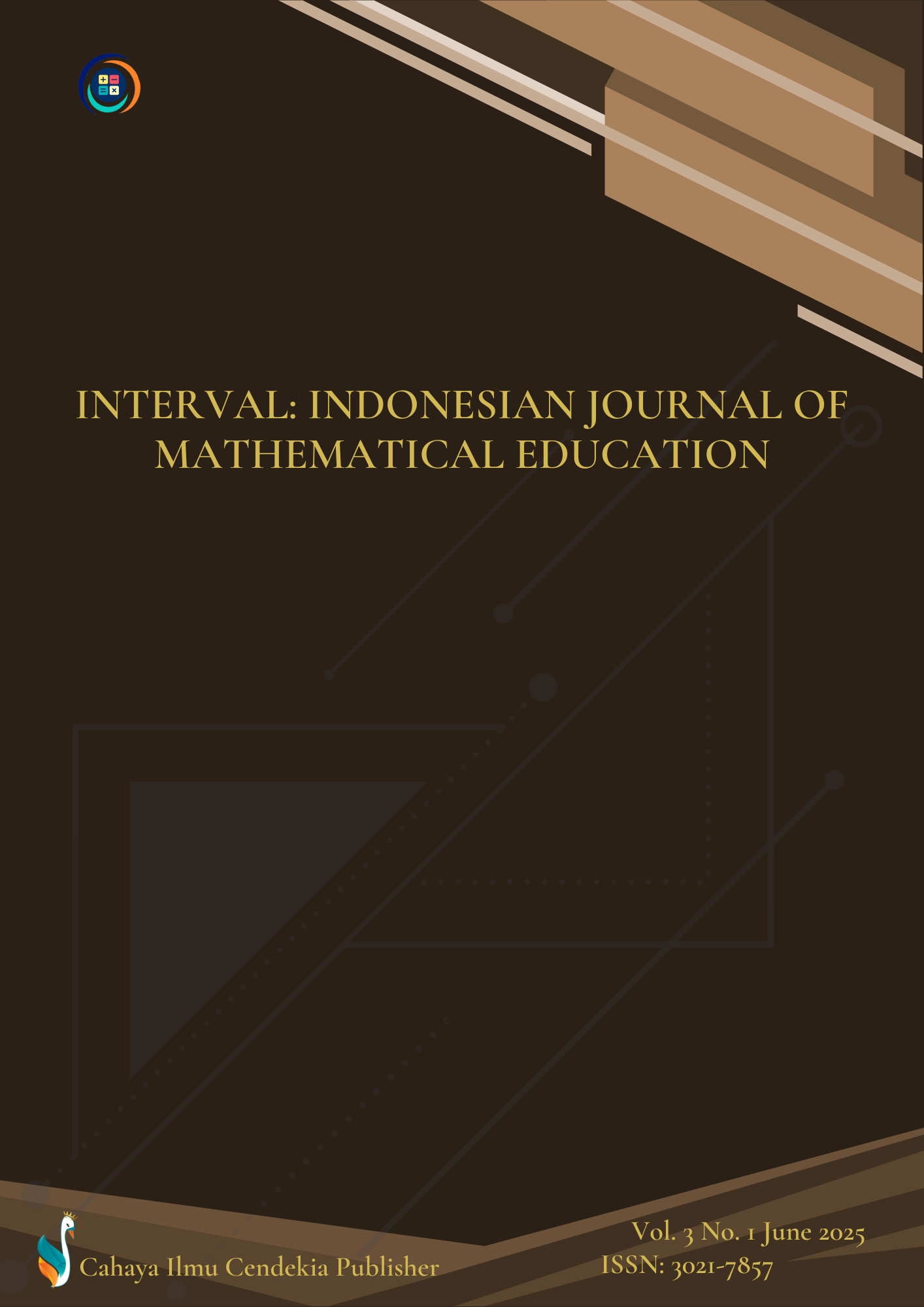Dynamic Analysis and Stability Evaluation of a Discrete Mathematical Model for Flying Fox String Vibrations
Abstract
Purpose of the study: This study aims to find the stability of changes in string deflection and the angle of string deflection when an object is launched along a flying fox.
Methodology:This study uses a model developed by Kusumastuti et al. (2017). There are two models analyzed, namely the discrete model of the string deviation y(t) and the angle of the string deviation θ(t). The analysis steps include model reduction, model discretization, model linearization, fixed point search, and stability analysis. Stability is analyzed based on the eigenvalues it has.
Main Findings:Based on the research conducted, the following eigenvalues were obtained: λ1 = -0.005h + (0.14565h)i, λ2 = -0.005h - (0.14565h)i, λ3 = -0.005h + (0.1331480769h)i, and λ4 = -0.005h - (0.1331480769h)i. The results of the study indicate that the system is in a stable condition (sink) because all eigenvalues obtained are complex numbers with negative real parts. Thus, it can be concluded that the rope deflection, rope deflection velocity, rope deflection angle, and rope deflection angular velocity are in a stable condition.
Novelty/Originality of this study: This study provides a new contribution to the understanding of discrete system dynamics in flying fox string vibrations, by showing that the stability of the system can be analyzed through the negative complex eigenvalues generated from the model.
References
M. Mo, L. A. Timmiss, T. Pearson, M. T. Kerr, S. Steves, and J. A. Welbergen, “‘Normalising’ flying-foxes: a bold vision for improving the public perceptions of our largest and most conspicuous bats,” Aust. Zool., vol. 43, no. 4, pp. 545–573, 2024, doi: 10.7882/az.2024.001.
S. H. Yabsley et al., “Variety is the spice of life: Flying-foxes exploit a variety of native and exotic food plants in an urban landscape mosaic,” Front. Ecol. Evol., vol. 10, no. August, pp. 1–17, 2022, doi: 10.3389/fevo.2022.907966.
C. Zhang, Z. Song, Y. Yang, C. Zhang, and Y. Guo, “A Decomposition-Based Multi-Objective Flying Foxes Optimization Algorithm and Its Applications,” Biomimetics, vol. 9, no. 7, 2024, doi: 10.3390/biomimetics9070417.
R. M. Napitupulu, D. S. Lubis, and J. Silitonga, “The Silima-Lima Waterfall’s Potential as Halal Tourism: A SWOT Analysis,” BISNIS J. Bisnis dan Manaj. Islam, vol. 10, no. 1, p. 99, 2022, doi: 10.21043/bisnis.v10i1.14552.
A. Machmury, “An Analysis Tourist’s Perceptions Toward Tourism Development: Secondary Tourist Attraction Study,” in SHES: Conference Series, 2024, pp. 73–82.
R. Aalloul, A. Elaissaoui, M. Benlattar, and R. Adhiri, “Emerging Parameters Extraction Method of PV Modules Based on the Survival Strategies of Flying Foxes Optimization (FFO),” Energies, vol. 16, no. 8, pp. 1–24, 2023, doi: 10.3390/en16083531.
M. T. Ibouroi, V. Arnal, A. Cheha, S. A. O. Dhurham, C. Montgelard, and A. Besnard, “Noninvasive genetic sampling for flying foxes: a valuable method for monitoring demographic parameters,” Ecosphere, vol. 12, no. 7, pp. 1–15, 2021, doi: 10.1002/ecs2.3327.
G. Jeong, H. Kim, H. S. Lee, M. Park, and H. Hyun, “Analysis of safety risk factors of modular construction to identify accident trends,” J. Asian Archit. Build. Eng., vol. 21, no. 3, pp. 1040–1052, 2022, doi: 10.1080/13467581.2021.1877141.
J. Duarte, A. Torres Marques, and J. Santos Baptista, “Occupational accidents related to heavy machinery: A systematic review,” Safety, vol. 7, no. 1, pp. 1–22, 2021, doi: 10.3390/safety7010021.
K. M. Styles, A. T. Brown, and A. P. Sagona, “A Review of Using Mathematical Modeling to Improve Our Understanding of Bacteriophage, Bacteria, and Eukaryotic Interactions,” Front. Microbiol., vol. 12, no. September, pp. 1–17, 2021, doi: 10.3389/fmicb.2021.724767.
O. J. Peter, F. A. Oguntolu, M. M. Ojo, A. Olayinka Oyeniyi, R. Jan, and I. Khan, “Fractional order mathematical model of monkeypox transmission dynamics,” Phys. Scr., vol. 97, no. 8, pp. 1–25, 2022, doi: 10.1088/1402-4896/ac7ebc.
G. Noorsumar, S. Rogovchenko, K. G. Robbersmyr, and D. Vysochinskiy, “Mathematical models for assessment of vehicle crashworthiness: a review,” Int. J. Crashworthiness, vol. 27, no. 5, pp. 1545–1559, 2022, doi: 10.1080/13588265.2021.1929760.
Q. Khan and R. Akmeliawati, “Review on system identification and mathematical modeling of flapping wing micro-aerial vehicles,” Appl. Sci., vol. 11, no. 4, pp. 1–30, 2021, doi: 10.3390/app11041546.
T. Li, “Application of Mathematical Model in Dynamic Analysis and Monitoring of Mechanical System,” Int. J. Front. Sociol., vol. 3, no. 8, pp. 36–46, 2021, doi: 10.25236/ijfs.2021.030806.
O. Afanaseva, O. Bezyukov, D. Pervukhin, and D. Tukeev, “Experimental Study Results Processing Method for the Marine Diesel Engines Vibration Activity Caused by the Cylinder-Piston Group Operations,” Inventions, vol. 8, no. 3, pp. 1–19, 2023, doi: 10.3390/inventions8030071.
V. G. Salunkhe and R. G. Desavale, “An Intelligent Prediction for Detecting Bearing Vibration Characteristics Using a Machine Learning Model,” J. Nondestruct. Eval. Diagnostics Progn. Eng. Syst., vol. 4, no. 3, pp. 1–15, 2021, doi: 10.1115/1.4049938.
A. E. Abouelregal, Ö. Civalek, and B. Akgöz, “A Size-Dependent Non-Fourier Heat Conduction Model for Magneto-Thermoelastic Vibration Response of Nanosystems,” J. Appl. Comput. Mech., vol. 11, no. 2, pp. 344–357, 2025, doi: 10.22055/jacm.2024.46746.4584.
J. H. Kusumastuti, “Analysis Construction of Mathematical Modelling of Flying Fox String Vibration,” J. Teknol., 2017.
P. Trucillo, “Drug Carriers: A Review on the Most Used Mathematical Models for Drug Release,” Processes, vol. 10, no. 6, pp. 1–24, 2022, doi: 10.3390/pr10061094.
S. B. Beale et al., “Continuum scale modelling and complementary experimentation of solid oxide cells,” Prog. Energy Combust. Sci., vol. 85, p. 100902, 2021, doi: 10.1016/j.pecs.2020.100902.
R. Dona and B. Ciuffo, “Virtual Testing of Automated Driving Systems. A Survey on Validation Methods,” IEEE Access, vol. 10, pp. 24349–24367, 2022, doi: 10.1109/ACCESS.2022.3153722.
Copyright (c) 2025 Aniq Nur Matsubah, Ali Hussein Al-Moders, Francis Pantino, Asgar Anda

This work is licensed under a Creative Commons Attribution 4.0 International License.
Authors who publish with this journal agree to the following terms:
- Authors retain copyright and acknowledge that the Interval: Indonesian Journal of Mathematical Education is the first publisher licensed under a Creative Commons Attribution 4.0 International License.
- Authors are able to enter into separate, additional contractual arrangements for the non-exclusive distribution of the journal's published version of the work (e.g., post it to an institutional repository or publish it in a book), with an acknowledgment of its initial publication in this journal.
- Authors are permitted and encouraged to post their work online (e.g., in institutional repositories or on their website) prior to and during the submission process, as it can lead to productive exchanges and earlier and greater citation of published work.





.png)
.png)














